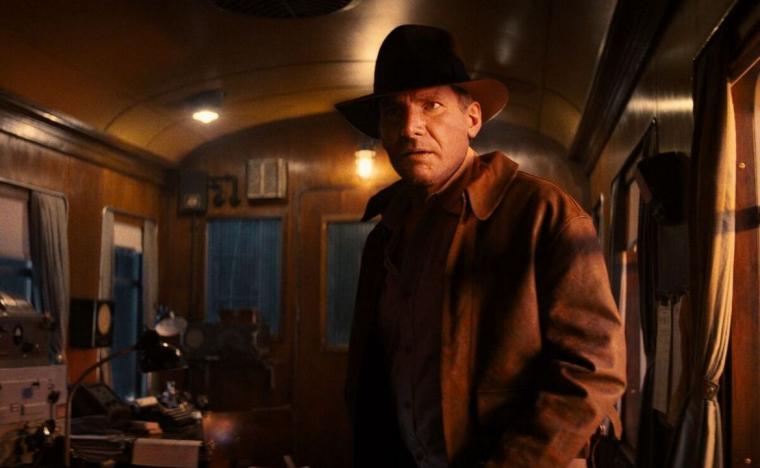
Harrison Ford in Indiana Jones and the Dial of Destiny
INDIANA JONES & THE DIAL OF DESTINY
It feels neither heretical nor obtusely argumentative to suggest that none of the sequels to Steven Spielberg's action-adventure Mt. Olympus Raiders of the Lost Ark have been truly great, though even the most negligible Indiana Joneses have boasted great things. (My personal favorites being, in chronological order, the “Anything Goes” opener in Temple of Doom, Sean Connery in Last Crusade, and Karen Allen's smile in Crystal Skull.) The franchise's first big-screen entry not directed by Spielberg, James Mangold's Indiana Jones & the Dial of Destiny isn't an across-the-board victory, either. But from its introductory 20 minutes involving an impressively de-aged Harrison Ford to the joyously ludicrous finale that's capped by a quiet emotional whopper, I think I had more fun at this fourth followup that at any previous post-1981 Indy outing. While these may still be leftovers from a decadently delicious meal, they're intensely tasty ones re-heated to just the right temperature.
What's especially satisfying and unexpected about the movie's success isn't that it's maybe the strongest Indiana Jones in more than four decades, or even that Mangold – a first-rate director in his own right – proves so able to mimic Spielberg's approach and style without losing sight of his own gifts for lean, effective thrills and dramatic heft. (The titles on Mangold's underrated list of credits include Cop Land, 3:10 to Yuma, The Wolverine, Logan, and Ford v Ferrari, and he guided Reese Witherspoon to an Oscar for Walk the Line.) It's that for the first time since Raiders, not only is the initial kick still present in the climactic scenes, but the film actually gets better and better as it goes along, continually escalating its narrative adventurousness, set-piece grandeur, and willingness to go in gonzo directions that make you ask, with a grin, “What the hell is gonna happen now?!”
During the 1944 prelude, it's amusing to watch Indy-in-his-prime run away from Nazis atop a speeding locomotive, but we've been here with the guy before. (If not, it certainly feels like we have.) Yet after the setting shifts to 1969, I'm not sure we've ever seen anything like the frenzied chase through a gaudy ticker-tape parade that leads to our hero, on horseback, racing his speeding stallion both away from and toward a pair of hurtling subway trains. And we've certainly never witnessed anything like what happens when we leave the realm of 1969 for yet another calendar destination, one I won't spoil, that leaves us as agog as any of the film's characters and makes a response of giggles as appropriate as gasps.
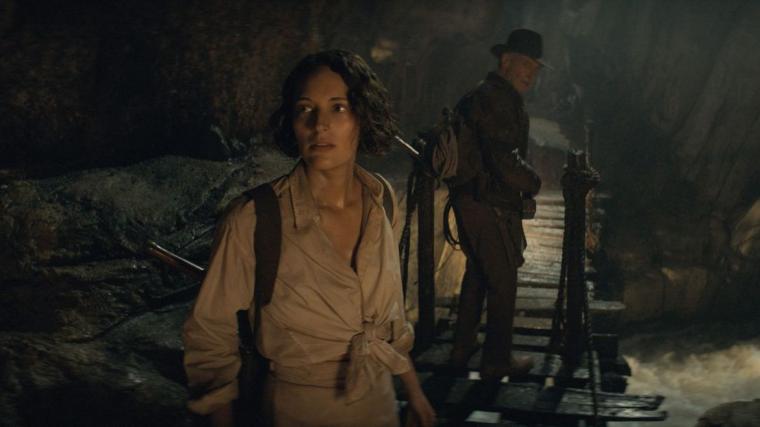
As with all Indiana Jones outings, Dial of Destiny concerns a globe-hopping trek to find a mythical, potentially all-powerful thingamajig, this one being the second half of a broken Archimedes contraption – the Antikythera – that can conceivably send its users back or forward in time. (This is not, however, the first archaeological object sought in the opener, and only in an Indy adventure, I'm guessing, could the fabled Lance of Longinus that drew Christ's blood on the cross be a film's second-most valuable tchotchke.) In 1944, fedora-wearing, whip-snapping Henry Jones and his dear friend and ally Basil Shaw (Toby Jones) walk off with the dial's first half.
Twenty-five years later, aging Indy, now a drunken and newly retired professor at Hunter College, is goaded into finding the second half with the arrival of a pair of figures from his past. One is Basil's daughter Helena (Phoebe Waller-Bridge), a brilliant chip off the ol' block with her own reasons for finding Archimedes' creation. The other is Jürgen Voller (Mads Mikkelsen), who last faced Indy when attempting to procure the dial remnant at the tail end of World War II. Do I need to mention that Voller was, and is, a Nazi? (Upon the release of 1993's Schindler's List, Spielberg made numerous public statements about not wanting to direct any more movies that turn Nazis into mere genre villains … but three decades later, I suppose he has no issue with executive-producing a movie that does just that.)
Presentation-wise, you hardly need Archimedes- or Jones-level intellect to guess how this quest will unfurl. But familiarity, here, is in no way a hindrance. It may be the movie's raison d'être. That's why it's such an extended pleasure to see the recognizable so frequently adjoined, enhanced, by the novel – or at least the novel in regard to this series. Yes, there's a feisty female companion on hand. But with Helena not only Basil's daughter but Indy's goddaughter, there's no possible threat of romantic byplay, and the woman's behavior routinely suggests, refreshingly, that she's a total asshole. (It's to Waller-Bridge's immense credit that fast-talking, wisecrack-spewing Helena isn't a pain to be around … though two seasons of Fleabag still keep me waiting for the moment in which the performer breaks the fourth wall with a sardonic aside.) Yes, there's an equally feisty young sidekick. But Ethann Isidore's charming pickpocket Teddy, with his wispy puberty mustache, holds his action-comedy own against his elders and doesn't waste your time making you think about Ke Huy Quan's Short Round or Shia LaBeouf's Indy Jr. (The latter of whom gets the franchise farewell many will likely think he deserves, though happily, it also leads into some devastatingly subtle emotionalism on Ford's part.) Yes, there are Nazis – as Indy accurately observes, “Too many Nazis.” But they get a first-rate Southern henchman in Boyd Holbrook, a veteran of Mangold's Logan who's almost helplessly charismatic, and Mikkelsen is a skilled practitioner of mainstream subversion. Only he and maybe Stellan Skarsgård could likely pull off a German fascist whose time-travel plans involve winning the war for Germany by killing Hitler.
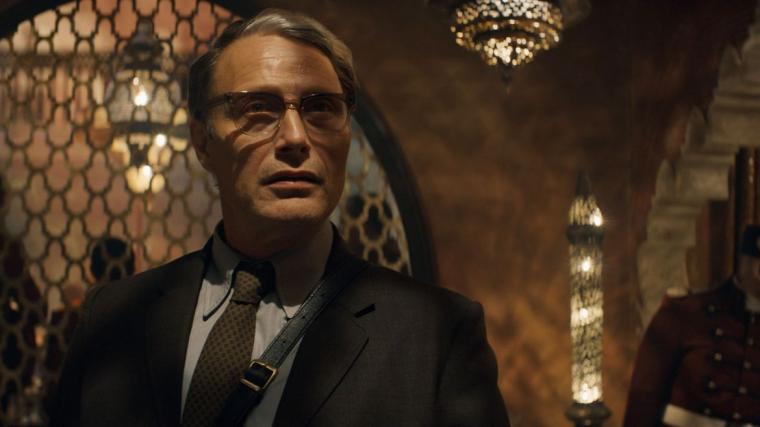
Holding the entire package together, it should go without saying, is Harrison Ford. Barring one intensely strange, distracting cameo, the supporting cast is aces, and Mangold gives his innumerable chase and escape sequences the proper vigor, even when the CGI effects threaten to waylay the staging. (There's far too much digital rain in a sequence that begs for clarity, and the squeamish, giggly promise of Indy encountering a school of moray eels – “They look just like snakes!” – is wasted with too much computerized eel and not enough glimpses at our submerged hero's panicked expressions.) Dial of Destiny, though, is an unquestionable love letter to its star and its star's alter ego, and Ford returns that adoration with witty resourcefulness and gravitas. Following the winning if somewhat destabilizing sight of Ford's youthful bearing grafted onto a stunt double who moves like no one in his late 70s ever could, 1969 Henry Jones is introduced not unlike Clint in Gran Torino, yet without the racial epithets. This, however, is no monolithic performance. It's an intensely human one, and while Ford's motions are clearly slower than they used to be, little effort is made to disguise that fact. Scaling a treacherous incline with Helena above him, this Indy delivers empathetic gripes about his body and health not being in the shape they once were, and the utterly endearing admission warms you to both the actor and the character is ways you may not have anticipated.
Truth be told, in advance of Mangold's film, I kind of thought I'd had enough of Indiana Jones for a lifetime, and the movie's relatively tepid box office indicates that loads of others may have felt the same way. But Indiana Jones & the Dial of Destiny is a heartening surprise. If you're feeling grumpy, there's plenty to moan about: the ridiculous contrivance of the narrative; the time-killing action choreography that lasts far longer than it needs to; Antonio Banderas. (It's generally nice to see him, but seriously: Why is he here?) Yet I spent nearly a full two hours and 30 minutes with a silly smile glued to my face, and for the first time ever during this series, at a pivotal moment, even had to fight the urge to cry. Empty nostalgic sentiment, as The Flash disastrously proved, is one thing. Deserved nostalgic sentiment, as evidenced here, is something else. In this case, a deservedly capitalized Something Else.
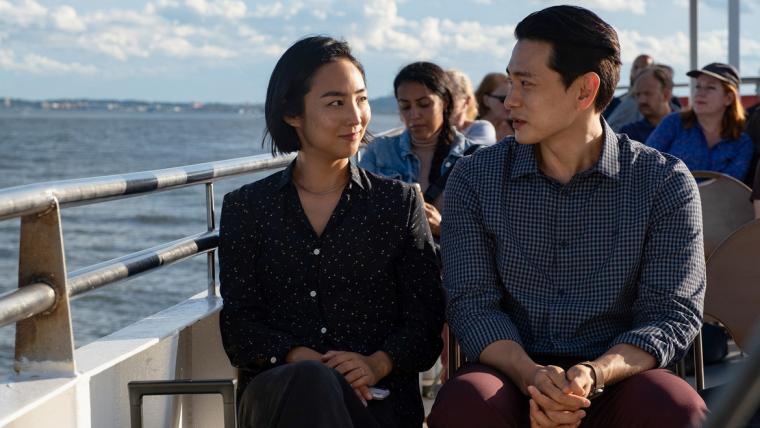
PAST LIVES
It's not often that you see two movies in one weekend expressly devoted to time travel. In Indiana Jones & the Dial of Destiny, the journey is literal. In writer/director Celine Song's extraordinary feature-film debut Past Lives, it's figurative – two souls, over the course of 105 minutes, moving forward in years yet ever-conscious that even their present might very well be a specific version of their futures. Its basic conceit is almost staggeringly simple: Two closely tied 12-year-olds become separated by geography, then reunite 12 years later, then reunite again 12 years after that. But despite the familiar, Moonlight-esque presentation and theoretically minimal stakes for those involved, this subtly devastating drama from those gut-punch perpetrators at A24 emerges as a true original, as well as a powerful meditation on romantic inevitability and fate. Dial of Destiny wouldn't have been a bad title for this release, either.
It might well have been a preferable one, because even to describe Song's narrative risks making Past Lives, with its abjectly generic title, sound more inconsequential than it ever is. In the film's first 15 minutes, we're invited into the worlds of Korean adolescents Na Young (Seung Ah Moon) and Hae Sung (Seung Min Yim), the former of whom we first meet crying because, as she's always been the smartest one in class, she's mortified to have just received a lower grade than that of her bestie/crush Hae Sung, who teasingly calls his friend “psycho” for her type-A tears. Even if they don't know it yet, the tweens are clearly in love. (Na Young tells her mother “I'm going to marry him someday” with the insouciance of making a breakfast order.) But an eventual union, it appears, isn't in the cards. Na Young's family is moving to Canada – she re-christens herself “Nora” in advance of the move – and the youths, with the boy obviously demolished and the girl trying to hide her sadness, part ways on a Korean street with a literal fork in the road: Na Young's path leading up a staircase, and Hae Sung's leading in a flat, straight line on the opposite side of the street. It might be the single most annihilating image I've ever seen that demonstrates, in purely visual terms, the apparent demise of a friendship.
But hooray for the Internet! As a 24-year-old struggling playwright now living in New York City, Nora (now played by Greta Lee), while on the phone with her mother, thinks to look up old friends on social media, and discovers that Hae Sung (now played by Teo Yoo) is not only alive and well in Korea, but has also made an active search for her. They reconnect via Skype, and are soon as involved in one another's lives as they ever were – this despite the geographic distance and vast differences in daily regimen and personality. (Nora is work-focused and artistic-minded; Hae Sung has recently finished his mandated military service and whiles away his hours getting drunk with friends.) It's a lovely extended reunion, but as Nora learns, one that isn't likely to lead to anything but creative and romantic stagnation given that neither is in a position to visit the other's country for several years. Nora, hiding her heartbreak, says it's time to take a pause. Hae Sung, visibly shattered, agrees. Then 12 more years pass, and Hae Sung, who has just broken up with a long-term girlfriend, has come to New York to visit Nora, who has, for years, been happily married to fellow author Arthur (John Magaro). She and Hae Sung meet in the park; they awkwardly reconnect; they find their old groove. But is this the beginning of something, or the inevitable end?
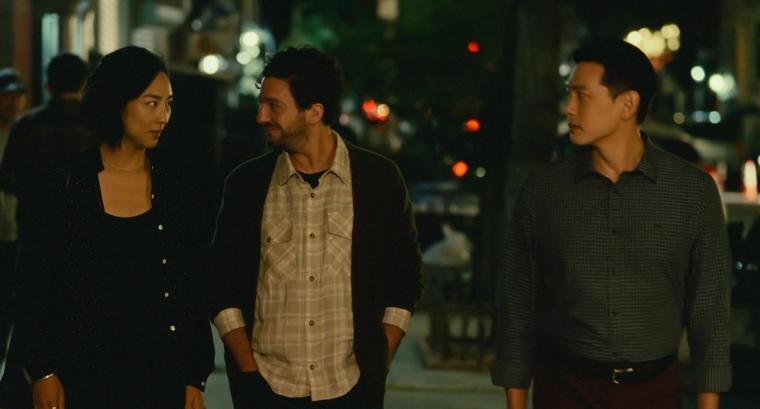
That I wasn't completely sure of the answer even five minutes before the closing credits is testament to the expansive strength of Song's achievement. Cinematic love triangles, of course, are nothing new. But exceedingly rare is the movie love triangle in which everything about characters' behavior suggests one result – in this case, that Nora and Arthur will stay together and Hae Sung will travel back to Korea alone – yet still, somehow, no end result feels secure. In Past Lives, that's due to the routinely referenced Korean philosophy of “in Yun,” which implies that there are no accidents, and that those who encounter one another frequently, or even once, have been in contact with one another, in some form, for up to millennia worth of former existences. A married couple, for instance, may have had to endure eight thousand lifetimes of random encounters in other forms before the universe finally decreed that, yes, these two are meant to be together forever. It's an almost unspeakably beautiful idea, yet one that sharply divides – or does it? – Song's central figures. Is this, as dramatized in Song's movie, the life that Nora's and Hae Sung's many previous lives have been leading to? Is Arthur, who still can't believe his good fortune in having Nora agree to marry him, the beneficiary of thousands of years worth of in Yung? Is either man, for Nora, the man she's meant to be with?
A movie review probably shouldn't feature the posing of so many questions without answers. So let me wrap this up with some declarations. I freaking adored this movie. An esteemed Canadian-Korean playwright herself, Song has an unerring knack for the employment of silence and drops exposition with the gentlest of touches. (I loved how, in her three separate time periods, Nora's career aspirations offhandedly shifted from first wanting a Nobel Prize, to then wanting a Pulitzer Prize, to finally settling on a Tony Award.) Song also writes exquisitely revealing dialogue that, in its easy, conversational manner, can take your breath away, as when Nora attempts to calm the anxious Arthur by saying “You're forgetting that I love you” and he replies “I never forget that – I just have a hard time believing it sometimes.” (I also instantly welled up when Nora posited that, in one of their previous lives together, she was a bird who landed on a branch of Hae Sung's tree.)
Song's three central performers – and aside from a few peripheral characters, it's basically a three-actor show – are all spellbinding in their graceful emotional subtlety and artifice-free expressiveness. Yoo and Magaro, their faces like metaphoric open wounds, are stunning. Lee, her Nora internally torn between past and present and fate and reality, is remarkable. Keith Fraase's editing is sharp and inventive. Shabier Kirchner's cinematography is acutely mood-setting. Composers Christopher Bear's and Daniel Rossen's score is elegiac and haunting. I can't wait to see Past Lives again. It's the love story of the year. Considering the theory of in Yun, maybe thousands of years.
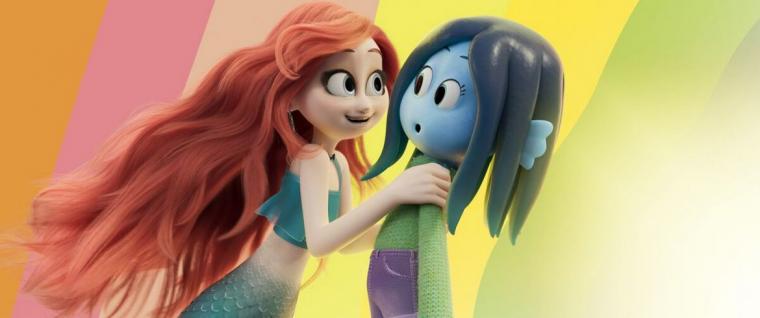
RUBY GILLMAN, TEENAGE KRAKEN
Sometimes all you want from your family-friendly animated comedies is an enormous blast of cleverly scripted silliness, and I got that and then some from Dreamworks Animation's Ruby Gillman, Teenage Kraken. Granted, in order to derive maximum fun from director Kirk DeMicco's offering, you'll have to agree not to be bothered by a few plot points that most five-year-olds would likely have a tough time swallowing. Such as the notion that a family of four skyscraper-sized Kraken would choose to live their disguised lives among humans in a seaside community with the parents able to hide their actual identities from their kids. And that they chose said seaside community for residence even though it would be catastrophic if any of them ever got wet. And that the family's human neighbors wouldn't be off-put by the Kraken clan being blue and having four fingers on each hand because they were, don'tcha know, Canadian. And that … . Wait. Why did I enjoy this movie?
Oh right: because it's routinely funny as hell. The animation is merely serviceable, not much better than what you'd get on a sub-premium cable service, and the regimented Life Lessons – “Be yourself!” “Don't Let Others Define You!” “Listen to your mother!” – are ladled on with maximum thickness. But the pre-calamity scenes of vocal performer Lana Condor's title character just dealing with regular teen stuff are enjoyable and smartly written. (I particularly liked Ruby's Goth pal insisting that his incessant focus on his phone was an act of “stress-gaming.”) And while too many current animated features employ a fabulous vocal cast without giving them nearly enough juicy comedy to vocalize, I'm delighted to say that Ruby Gillman, Teenage Kraken is not one of those movies. Condor's readings are dandy, but I was far more tickled by Toni Collette as Ruby's overprotective mom, Colman Domingo as her Dad Joke dad, Sam Richardson as the goofy uncle without a spinal cord, and Schitt's Creek's Annie Murphy as a snobby mermaid, her cadences indicating that the next line out of her mouth will always be “Oooooo … burn, David!” Will Forte, voicing a sailor unable to take a proper selfie, made me laugh out loud with his seafarer's heavily accented misery over his recent divorce to an apparent harridan named Tammy. And in her fourth movie “appearance” of 2023 to date, Jane Fonda voices the Kraken grandma, her riotous haughtiness when offering her granddaughter cookies culminating in a line I am committed to stealing and subsequently using forever: “I made someone make them myself.”










